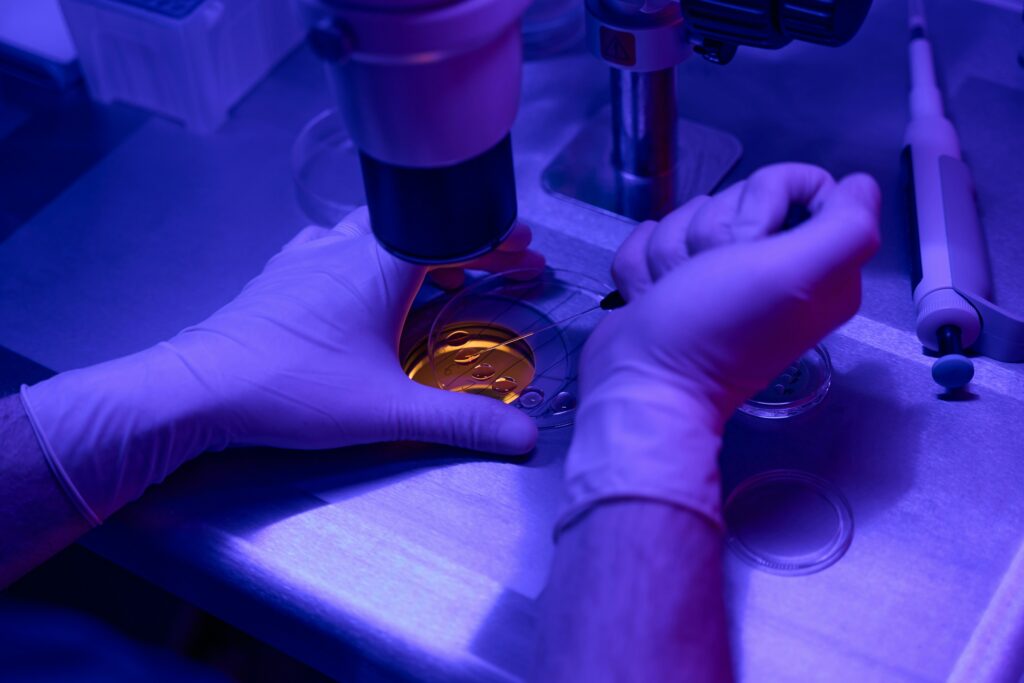If you’re reading this, it’s for a reason—and we’re sorry for it. Dealing with infertility is a battle that is hard to prepare for when you desperately want to have a baby. It’s not just an emotional experience for women and couples but it comes with a hefty price tag and intense financial burden.
For women and couples experiencing and navigating infertility, doctors may eventually recommend exploring in vitro fertilization, or IVF. IVF is a process that involves several steps, called an “IVF cycle.” While every individual is given a unique protocol, prescriptions and process, generally speaking, female patients take fertility drugs to help their ovaries produce eggs, which are then retrieved and fertilized with sperm in a laboratory.
These become embryos, which are then transferred to your uterus. If the embryo attaches, pregnancy occurs. Two percent of babies in the United States are born with the help of IVF. That’s eight million babies! These are not just numbers, they are stories of hope and success.
This life-changing medical advancement has been helping families for decades, but unfortunately, it doesn’t come cheap. And most of the time, it isn’t covered by insurance. Factors that can impact cost:
- Number of cycles
- Location
- Clinic medications
- Age
- Lab costs
In this IVF cost guide, we help you understand the price tag of IVF and how to navigate its financial side so you know exactly what to expect.

The Average IVF Cost
The average price tag of IVF ranges from $15,000 to $30,000 for one IVF cycle in the United States. Yep: that’s just one cycle. One study showed that most women have success with IVF in their sixth cycle—and that’s before you even factor in some of the extra costs that can come along with it.
IVF isn’t just about the procedure itself. The medications you need will alone cost between $2,000 and $7,000. Then you have to factor in your lab fees, doctor fees, ultrasounds and blood tests—each piece of the process adds up. Factors like age, geographic location and fertility diagnosis can also impact the price tag of IVF.
Age:
Dr. Dan Nayot, one of North America’s leading reproductive endocrinologists and infertility specialists and Chief Medical Advisor at Bird&Be, shared just how age and location affect price. He explains that while women age IVF often becomes more complicated as additional interventions like preimplantation genetic testing for aneuploidy (PGT-A) may be needed. Older women may need more doses of medication which can also increase the costs. But Dr. Nayot recommends using at-home tests which can test your ovarian reserve and save money.
Location:
Your geographic location can also affect your IVF costs due to differences in cost of living.
“Clinics in major cities or regions with high living costs may charge more for IVF services compared to those in rural or less expensive areas. Clinics in areas with higher demand or those with advanced technology and higher success rates may have higher fees. In some regions, IVF clinics may be limited or unavailable locally,” Dr. Nayot said. As you travel and arrange hotels or accommodations, your costs can increase. Certain regions might even have different regulations when it comes to fertility treatments that can also drive up the cost.
Fertility diagnosis:
The price tag of IVF can also be driven up by fertility diagnosis. Different diagnoses can mean different treatments, medications, or amounts of cycles. For example, if you need to use a donor egg in your process, you might be paying an additional $10,000 to $15,000. If you have polycystic ovary syndrome (PCOS), your egg quality might be negatively affected, which means you might need additional medications to improve your fertility, increasing the price tag of IVF.

Cost-Saving Tips for IVF:
If you’re looking into IVF, we know the costs can be overwhelming, but there are things you can do to save a bit of money here and there. When you look to save money during IVF, there are several things you should consider. Dr. Nayot created this list for patients.
- Insurance coverage: All patients should check if this is an option for them, as many are unaware that some or all components might be covered.
- Speak to your fertility doctor: They can help you explore options to decrease cost without negatively impacting success rates, such scenarios where using less expensive oral medications instead of more costly injections is an option, like oral progesterone medications to prevent early ovulation, or reconsidering unnecessary IVF add-ons.
- Take a prenatal: Begin taking a prenatal at least three months in advance of beginning IVF treatments to improve your outcome with fewer rounds of treatment for both males and females.
- Explore clinical trials: Some fertility clinics offer participation in clinical trials for new treatments or medications, which may reduce costs or even provide free treatment.
- Travel for IVF: Consider fertility treatment in another state or country. In some cases it might be an overall less expensive alternative, even when you factor in additional expenses, like flights and lodging.
After you consider these, you might still want to look into potential discounts or financial assistance programs because every little bit of savings can make a difference. Many clinics offer reduced prices through discount packages. You would pay upfront for a specific amount of cycles, which would be more affordable than paying for each cycle one at a time. Programs like BabyQuest Foundation and Gift of Parenthood offer families financial assistance to help cover some of the costs of IVF.
You can also reduce the costs by asking your clinic or a third party company that offers a technology that can determine your chance of success for fertility treatments.
“For example, if my likelihood of success is 50 percent greater by using a donor egg vs using my own eggs, I may choose that option from the start,” Leyla Bilali, the Chief Clinical Officer at Dandi Fertility. You can also research data on your clinic at at SART.org to get an idea of your costs.
When looking at ways to finance your IVF journey, there are a few things you should look into when trying to reduce IVF’s price tag. Research fertility-specific loans that are designed specifically for IVF expenses. Companies like CapexMD provide loans that can be tailored to your specific needs with IVF. You could apply for grants and scholarships from organizations we mentioned before or research if your clinic has grants that provide financial aid.
Crowdfunding can also be a way to raise money. Through platforms like GoFundMe and the support of your family, friends and community, you can raise funds for your IVF cycles.
Most importantly, you need to look at what your insurance covers. Depending on your insurance and where you live, part or all of your IVF costs may be covered. You can also look at your employer to see if your benefits cover fertility costs. For example, Google provides funds to their employees for up to four cycles of IVF.
Through researching and exploring these options, you can create a plan that fits and understands your budget.
The price tag of IVF can be extremely expensive. The cost per cycle is already high but when you factor in medication, lab costs, doctor fees and your own factors like age, location and fertility diagnosis, everything can quickly add up. It’s so important to research and compare clinics where you are seeking IVF treatment.
Costs and financial assistance vary from clinic to clinic, so sitting down and comparing them can help you find a clinic that fits your needs. If you’re seeking IVF, just know that you’re not alone. As we mentioned, so many babies are born from IVF, but the journey for couples to get their babies is not easy by any means. Looking into the financial side might be scary and overwhelming—but it’s essential to understand the price tag of IVF.
Author
-

Esha Minhas is a third-year student at Northeastern University studying Journalism and Political Science. She's currently the editorial and social intern for Mila & Jo Media. Esha is also the Deputy Sports Editor for The Huntington News and covers Northeastern men's hockey. When she's not busy with work or school, you can find her at the gym, baking for her friends and family and watching anything sports related.
View all posts





